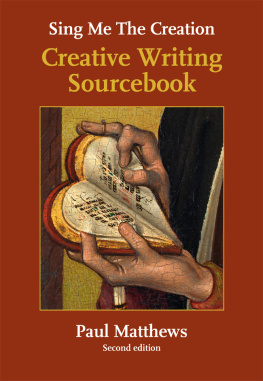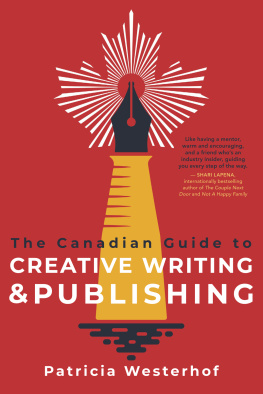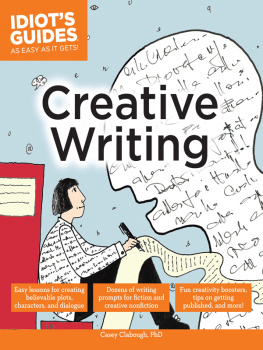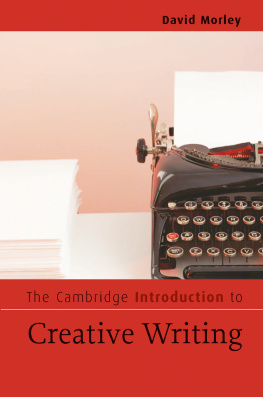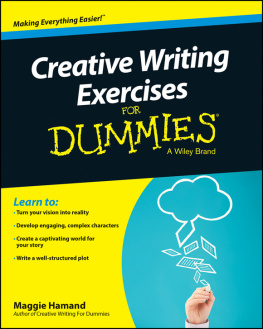Sing Me The Creation
A Creative Writing Sourcebook
by
Paul Matthews

Sing Me The Creation 2nd Edition 2015 Paul Matthews.
Paul Matthews is hereby identified as the author of this work in accordance with section 77 of the Copyright, Designs and Patent Act, 1988. He asserts and gives notice of his moral right under this Act.
Published by Hawthorn Press, Hawthorn House,
1 Lansdown Lane, Stroud, Gloucestershire, GL5 1BJ, UK
Tel: (01453) 757040 E-mail:
Website: www.hawthornpress.com
All rights reserved. No part of this book may be reproduced, stored in a retrieval system or transmitted in any form by any means (electronic or mechanical, through reprography, digital transmission, recording or otherwise) without prior written permission of the publisher.
Cover Image: Detail from Portrait of a Young Man, by Master of the View of St. Gudula, courtesy of The National Gallery.
Illustrations by Lee Hannam, Yellow Fish Designs.
Author photographs: p. iv, Tatjana Zuboff; cover, Signe Schaefer.
Cover design by Hawthorn Press.
Typesetting by Winslade Graphics.
Printed by Henry Ling Ltd, The Dorset Press, Dorchester.
Printed on chlorine-free paper sourced from sustainable managed forests.
Every effort has been made to trace the ownership of all copyrighted material. If any omission has been made, please bring this to the publishers attention so that proper acknowledgement may be given in future editions.
The views expressed in this book are not necessarily those of the publisher.
British Library Cataloguing in Publication Data applied for.
ISBN 978-1-907359-63-7
eISBN 978-1-912480-20-3
Sing Me The Creation
Paul Matthews
A book of exercises to develop the craft and imaginative faculties required for writing creatively. Though intended for group work with adults the book has also proved inspirational for teachers of children. Counsellors and social workers could make good use of it. Those writing alone would find it to be a helpful companion.
Dedication
To Francis and Elizabeth Edmunds
who saw the potential
To my many students and colleagues
who coaxed it out of me
To my wife Margli who has cherished it
About the Author

Paul Matthews, who works at Emerson College in Sussex, United Kingdom, is a widely published poet. Two gatherings of his poetry currently available are The Ground that Love Seeks and Slippery Characters (both from Five Seasons Press). His book Words in Place (also published by Hawthorn Press) is a further exploration of the creative process. He is acclaimed as speaker of his poetry and for the joyful interactive sessions in creative writing that he offers.
Online: www.paulmatthewspoetry.co.uk and Because We are Doing This: a Poetic Dialogue give more information about his work.
Acknowledgements
I wish to name specifically those who as writers, storytellers, speech artists, language teachers and counsellors have contributed to my writing courses and (in often intangible ways) to the content of this book: Ashley Ramsden, Andie Lewenstein, Lindsay Dearlove, Janis MacKay, Christopher Garvey, Louise Coigley, Glenys Waters, and Margli Matthews. Dawn Langman, Andrew Wolpert, Sue Hollingsworth and Roi Gal-Or are other colleagues who helped temper my words (that list is endless).
Michael Rose and Kristin Mathis have been generous speaking partners as I prepared this second edition, and Lee Hannam prepared the diagrams and illustrations. I thank them for that. Also Anthony Nanson for his editing of introductory pages. As for Martin Large, my publisher, I was already grateful that he accepted the book twenty years ago, and now, on account of his gentle persistent probing for further potential I am even more so. It would have been no book at all, though, if Claire Percival and her team had not shaped it so beautifully for the page.
Many of the examples for exercises arose out of group work, some collaboratively, some individually, and (wherever possible) the writers have been acknowledged. Some appeared previously in a booklet entitled Poetry Around the Table, produced by the Friends of the School for Speech Formation, at Peredur Centre for the Arts, East Grinstead. Others are drawn from Treetops, a gathering (unpublished) made by Barbara Hollander out of group work with the author. Experimental pieces and poems by Paul Matthews which arose in the writing circle are also included.
The author thanks the following for permission to reproduce copyright material:
The National Gallery, London: Master of the View of St Gudula, Portrait of a Young Man. Glasgow Museums: Adam Naming the Beasts and Eve Naming the Birds by William Blake. Julian Rothstein, Redstone Press: The Ghosts of my Friends. Wooden Books for use of image from Runic Inscriptions in Great Britain, Paul Johnson.
Contents
First the making of this book is placed in a personal and historical context. Its path and practice are then enlarged upon, inhibitions recognised and creative permissions granted. Once initial aims have been stated, the writing begins social exercises to help with group forming. Word play with nouns, verbs and adjectives expands into a consideration of the poetic line, sentences and paragraphs. Four basic sentence types are introduced in a diagram as seeds for our work together, and the elements of Earth, Water, Air and Fire lend their qualities to both language and movement. This fourfold archetype, introduced here, gives structure and direction to the book.
With the act of naming as our first concern we exercise the faculties of observation and imagination so essential for any creative writer. A distinction is made between definition and characterisation. Permissions in the use of metaphor then help us to perceive the inwardness of outer things and to name what lives inside us. After these basic practices we follow step by step the ways in which images come to us present observation, memory, paintings, dreams, fantasy and word play and these inform our writing. Can imagination serve the truth? As the chapter ends we consider this question in the context of the evolution of human consciousness.
Asking questions (and the dialogue this calls for) is another fundament of language. We explore what serves true conversation then practise it in written collaboration with a partner. This takes various forms: party games, bragging contests, conversations between opposites. The dynamics of giving and receiving are revealed through simple movement exercises. What starts as permission and crafting deepens into the writing (and responding to) of letters which, even if fictional, give scope for our hearts to find a voice. We reflect on how in many cultures questions and riddles are employed for the changing of human consciousness.
No new writing tasks are suggested here, but an exercise in movement helps us understand the figure of Mercury (or Hermes) which holds the centre of the fourfold diagram that has accompanied our work. This diagram is now explained more fully, and Mercurys healing aspect leads us to consider how, through a path of right speech, our use of language can find healing. The author takes the liberty of speaking for Hermes.

